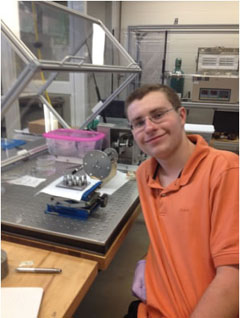Oct 16 2014
A summer of research certainly paid off for Christian Lipa, a sophomore in mechanical engineering, who decided to take a step outside his comfort zone and delve into the world of nanotechnology (the study of tiny particles) in the University of Cincinnati Nanoworld Lab.
 Christian Lipa spinning CNT
Christian Lipa spinning CNT
Department of Mechanical Engineering Professor Mark Schulz, who is also a co-director with Vesselin Shanov of the Nanoworld Laboratories, served as Christian’s research mentor, along with graduate student Anli Wang.
Christian participated in the Research Experience for Undergraduates (REU) funded by NSF. The program “supports active research participation by undergraduate students in any of the areas of research funded by the National Science Foundation.”
Lipa came into REU with very little previous knowledge of nanotechnology. In preparation for his research in the lab, Professor Schulz suggested Christian read a series of books including Nanomedicine Design of Particles, Sensors, Motors, Implants, Robots, and Devices, with a Supplementary Materials and Solutions Manual. Through his readings Christian established a firm foundation for his research. Professor Schulz says, “Christian applied his knowledge from the readings to critically analyze problems that arose in his work, and came up with practical and creative solutions.”
After reading and attending the bi-weekly meetings with a Nanomedicine group to better understand the type of research undergraduates were conducting in Nanoworld, Christian began his research spinning carbon nanotube (CNT) threads.
Professor Schulz explains, “The undergraduates focused on improving carbon nanotube (CNT) conductivity, developing biodegradable implants, and other areas of complex research.”
Carbon nanotubes (CNT) are tiny tubes of pure carbon which can be grown into what is called a “forest” of CNT. Once the CNT forest, which resembles a small black square of felt, is created on a surface, researchers can pull on the tip of the CNT clumps, forming a web as the strain is pulled away from the bundle. This strain then becomes a tiny fiber of carbon nanotubes. Multiple single fibers can be spun together with others forming a strong thread with great capabilities.
Lipa’s undergraduate research focused on the mechanical properties of carbon nanotubes. He worked on developing high strength (CNT) thread using mechanical methods. “After spinning thread, Anli and I would test it on a tensile testing machine and graph our data using MATLAB, a softwear package for sophisticated mathematic analysis and display.” explains Christian. “Improving the mechanical properties of CNT would make it an ideal material for medical implants and improving pre-existing fabrics.”
Carbon nanotubes have a high level of conductivity, meaning the threads spun from CNT can conduct electric currents. In a real world application, this may eventually lead to “smart clothing” which could monitor and adjust to your body’s changing temperature.
Christian worked on several projects relating to CNT threads including building a pressure calibration device (manometer) to conduct further tests on CNT posts and helping to write a proposal for funding for undergraduate research. Schulz continues by saying, “Christian was resourceful and built what was needed out of the materials available. He also made the lab environment safer for everyone by creating a shield to cover one of the spinning machines various individuals used in the lab.”
Christian’s hard work didn’t go unnoticed as Schulz says, “Christian put in the time and effort necessary to work on an advanced research project at Nanoworld which shows his adaptability in a new work environment.”
The flexibility and adaptation is an important skill in young researchers. Lipa certainly benefitted from his undergraduate experiences. “Conducting research as an undergraduate allowed me to gain experience with college laboratories function and prepared me for research as a graduate student if I decide to attend graduate school. My experience challenged me differently than normal problem solving.”
Christian enjoyed his summer research so much so that he decided to continue learning more about nanotechnology. Christian looks forward to applying his newfound knowledge in the broader world of mechanical engineering. “My research experience led me to determine that I would like to pursue a minor degree in nanotechnology at UC in order to learn more about the theory and possible applications of nanomaterials.”
In addition to finding a new research interest, Lipa also improved skills applicable to his work both in the classroom and his co-op placement. “The continual challenges in my research presented me with the opportunity to develop my critical thinking, creativity, and ability to work on my feet to come up with solutions to new problems.”
Professor Schulz echo’s Lipa’s “take-aways” as he continues by saying, “Christian was able to think on his feet to come up with solutions to problems that arose… By working with a PhD student, Christian became more confident in his abilities.”
The opportunity to collaborate with professors and graduate students earlier in an academic career can yield tremendous results. Students can use their experiential knowledge and apply it to coursework and co-op challenges. They may even discover a new research interest, much like Christian did in the nanolab. Lipa advises other undergraduate students who are interested in conducting research to “take the initiative and seek out faculty and professors at UC who fit best with your interests.”
The experience proves to be beneficial to both mentors and students alike. Christian’s impact in the lab advanced the existing projects. “He has grown as a researcher by developing both an understanding of the lab environment and forming valuable relationships with many of my colleagues, both graduate and undergraduate,” says Professor Schulz.
Professor Schulz closes by saying, “Christian Lipa’s extraordinary performance and professionalism as a REU student in the Nanoworld Lab exemplifies the high level of talent at UC.”